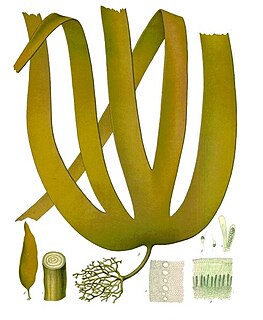
Treponema pallidum is a spirochaete bacterium with various subspecies that cause the diseases syphilis, bejel, and yaws. It is transmitted only amongst humans. It is a helically coiled microorganism usually 6–15 μm long and 0.1–0.2 μm wide. T. pallidum's lack of metabolic pathways results in minimal metabolic activity. The treponemes have a cytoplasmic and an outer membrane. Using light microscopy, treponemes are visible only by using dark field illumination. Treponema pallidum consists of three subspecies, T. p. pallidum, T. p. endemicum, and T. p. pertenue, each of which has a distinct associated disease.

Phycology is the scientific study of algae. Also known as algology, phycology is a branch of life science.

The Sargasso Sea is a region of the Atlantic Ocean bounded by four currents forming an ocean gyre. Unlike all other regions called seas, it has no land boundaries. It is distinguished from other parts of the Atlantic Ocean by its characteristic brown Sargassum seaweed and often calm blue water. A similar Sargasso sea is not found in the South Atlantic Ocean

Sargassum is a genus of brown macroalgae (seaweed) in the order Fucales. Numerous species are distributed throughout the temperate and tropical oceans of the world, where they generally inhabit shallow water and coral reefs, and the genus is widely known for its planktonic (free-floating) species. Most species within the class Phaeophyceae are predominantly cold-water organisms that benefit from nutrients upwelling, but the genus Sargassum appears to be an exception. Any number of the normally benthic species may take on a planktonic, often pelagic existence after being removed from reefs during rough weather; however, two species have become holopelagic—reproducing vegetatively and never attaching to the seafloor during their lifecycles. The Atlantic Ocean's Sargasso Sea was named after the algae, as it hosts a large amount of Sargassum.

Laminaria is a genus of brown seaweed in the order Laminariales (kelp), comprising 31 species native to the north Atlantic and northern Pacific Oceans. This economically important genus is characterized by long, leathery laminae and relatively large size. Some species are called Devil's apron, due to their shape, or sea colander, due to the perforations present on the lamina. Others are referred to as tangle. Laminaria form a habitat for many fish and invertebrates.

Nostoc is a genus of cyanobacteria found in various environments that forms colonies composed of filaments of moniliform cells in a gelatinous sheath.

Porphyra is a coldwater seaweed that grows in cold, shallow seawater. More specifically, it belongs to red algae phylum of laver species, comprising approximately 70 species. It grows in the intertidal zone, typically between the upper intertidal zone and the splash zone in cold waters of temperate oceans. In East Asia, it is used to produce the sea vegetable products nori and gim. There are considered to be 60 to 70 species of Porphyra worldwide and seven around Britain and Ireland where it has been traditionally used to produce edible sea vegetables on the Irish Sea coast. Porphyra is a chief source of plant-based vitamin B12.

AlgaeBase is a global species database of information on all groups of algae, as well as one group of flowering plants, the sea-grasses.

Ludwig Karl Georg Pfeiffer, also known as Louis Pfeiffer, was a German physician, botanist and conchologist.

Caulerpa lentillifera is a species of bryopsidale green algae from coastal regions in the Indo-Pacific. This seaweed is one of the favored species of edible Caulerpa due to its soft and succulent texture. It is traditionally eaten in the cuisines of Southeast Asia, Oceania, and East Asia. It was first commercially cultivated in the Philippines in the 1950s, followed by Japan in 1986. Both countries remain the top consumers of C. lentillifera. Its cultivation has since spread to other countries, including Japan, Vietnam, Taiwan, and China. C. lentillifera, along with C. racemosa, are also known as sea grapes or green caviar in English.

Saccharina japonica is a marine species of the Phaeophyceae plant, a type of kelp or seaweed, which is extensively cultivated on ropes between the seas of China, Japan and Korea. It is widely eaten in East Asia. A commercially important species, S. japonica is also called ma-konbu (真昆布) in Japanese, dasima (다시마) in Korean and hǎidài (海带) in Chinese. Large harvests are produced by rope cultivation which is a simple method of growing seaweeds by attaching them to floating ropes in the ocean.

Sargassum muticum, commonly known as Japanese wireweed, is a large brown seaweed of the genus Sargassum. It is an invasive seaweed with high growth rate. It has an efficient dispersion thanks to its floats.
Sargassum miyabei is a species of seaweed native to East Asia and Southeast Asia, from eastern Russia and Japan to Vietnam and the Philippines. It belongs to the subgenus Bactrophycus, section Teretia of the genus Sargassum.
Sargassum horneri is a species of brown macroalgae that is common along the coast of Japan and Korea. It is an annual algae which has a varying fertile season along the coast. In Wakasa Bay it began to grow in early autumn through winter, becoming matured in Spring, when the sea water temperature was 11.6–15.2 °C (53–59 °F) in average. Also called "devil weed", this species has invaded the Eastern Pacific, beginning in Baja California and advancing north along the California coastline.
Ceramium pallidum is a small marine alga. It occurs in waters off of Europe and Africa (Morocco).











